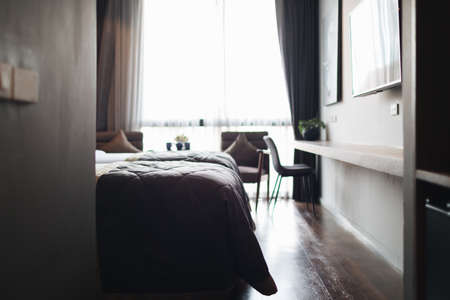Setting the Scene: The Evolution of Window Dressing in the UK
In Britain, the way we dress our windows has always reflected more than just a need for privacy or insulation—it’s a mirror of our social history, architectural trends, and evolving tastes. From the stately homes of the Georgian era, where heavy drapes in sumptuous fabrics signalled wealth and refinement, to the crisp minimalism favoured in today’s urban flats, curtains, blinds, and shutters have charted a fascinating course through British life. In grand Regency terraces, swathes of velvet framed tall sash windows, helping to keep out the draughts while adding a theatrical touch to drawing rooms designed for entertaining. As Victorian values ushered in an age of propriety and domestic comfort, lace curtains became ubiquitous, offering a delicate buffer between public street and private family life. Fast forward to the twentieth century and beyond, shifting lifestyles and modern materials saw roller blinds and wooden shutters gain popularity—valued as much for their clean lines as their practicality. Today, whether in a London townhouse with sleek Venetian blinds or a country cottage adorned with floral chintz curtains, window dressings remain an essential element of British interiors, quietly weaving together tradition and contemporary living.
2. Curtains: Tradition, Elegance, and the British Home
In Britain, curtains are far more than a mere functional element; they are a tapestry woven with threads of tradition, heritage, and domestic identity. Throughout history, curtains have played a central role in defining both the aesthetic and emotional atmosphere of the British home. Their evolution is deeply interwoven with the nation’s textile industry—one of the cornerstones of Britain’s industrial revolution—and their presence in a room often signals warmth, comfort, and a subtle assertion of privacy.
The Historic Roots of British Curtains
Curtains first gained prominence in grand English country houses during the late medieval period, evolving from simple draperies to ornate displays of wealth and taste by the Georgian and Victorian eras. Velvet, damask, and chintz became popular choices for stately homes, while lace curtains signalled refinement in urban townhouses. The following table illustrates some key historical styles:
| Era | Popular Fabric | Common Motifs | Symbolic Value |
|---|---|---|---|
| Georgian | Silk, Damask | Paisley, Floral | Status & Sophistication |
| Victorian | Velvet, Lace | Botanical Patterns | Moral Respectability & Privacy |
| Edwardian | Linen, Cotton Sateen | Pale Florals, Pastels | Aspirational Modernity |
Textile Heritage and Regional Identity
The UK’s textile-producing regions—Lancashire for cottons and Yorkshire for woollens—have profoundly influenced curtain styles. Local weaves and dyes gave rise to regionally distinctive patterns that persist in contemporary interior design. For many British families, choosing fabrics is about more than decoration; it’s about honouring local craftsmanship and sustaining a sense of place within their homes.
Curtains as Guardians of Privacy and Warmth
The symbolism attached to curtains is distinctly British. With rows of terraced houses facing the street, drawn curtains signal both privacy from prying eyes and a sanctuary against the chill of damp winters. The ritual of ‘drawing the curtains’ at dusk is still an ingrained part of daily life across the UK—embodying not only physical comfort but also emotional security.
Modern Interpretations and Enduring Appeal
Today’s British homeowners continue to favour curtains for their ability to soften interiors, frame views with elegance, and evoke a sense of continuity with the past. Whether it’s heavy velvet drapes in a period property or light linen panels in a contemporary flat, curtains remain an unmistakable hallmark of British domestic culture—a blend of tradition, practicality, and understated charm.

3. Blinds: Minimalism Meets Practicality
In recent decades, blinds have carved out a distinctive niche in UK interiors, reflecting not only aesthetic inclinations but also evolving lifestyles and urban realities. The shift from traditional drapery to sleek blinds marks more than just a change in taste; it signals a broader cultural embrace of minimalism and utility. As British cities grew denser and living spaces became more compact, homeowners increasingly sought window treatments that offered both practicality and style without overwhelming smaller rooms.
Blinds, with their crisp lines and unobtrusive profiles, embody the spirit of contemporary simplicity. Their rising popularity is closely tied to the UK’s urbanisation and the modern need for flexible, space-saving solutions. Unlike voluminous curtains, blinds—whether Venetian, roller, or vertical—can be neatly tucked away, maximising daylight and lending interiors a clean, uncluttered look. This preference for understated elegance resonates strongly with younger generations who value functional design over ornate embellishments.
Moreover, blinds offer exceptional control over privacy and light—essential considerations for city dwellers surrounded by neighbouring buildings. The ability to tilt slats or adjust fabric levels allows residents to tailor their environment with precision, striking a balance between openness and seclusion. This adaptability aligns perfectly with the fast-paced, ever-changing rhythms of contemporary British life.
The influence of global trends cannot be overlooked either. Scandinavian-inspired minimalism has found fertile ground in the UK, encouraging homeowners to opt for neutral tones and streamlined forms in their decor choices. Blinds serve as a canvas for this pared-back aesthetic, blending seamlessly into diverse interior schemes while supporting an ethos of ‘less is more.’
In summary, the rise of blinds in UK homes is a testament to changing priorities: efficiency over excess, clarity over clutter. Their growing presence reflects not just a practical response to modern challenges but also an evolving cultural narrative—one that values simplicity, adaptability, and quiet sophistication at the heart of British living.
4. Shutters: Roots, Revival, and Regional Influences
Shutters have a distinctly British backstory, emerging centuries ago as practical features in rural cottages and manor houses. Traditionally crafted from robust timber, they served as both insulation against the damp chill of British winters and a security measure for valuable homes. These early shutters were often painted in muted greens or classic whites, blending with the rolling countryside and echoing the restrained aesthetic of Georgian and Victorian architecture.
In recent years, shutters have experienced a stylish revival across the UK, particularly in city flats and period property conversions. Modern homeowners are rediscovering their charm—not only for their aesthetic appeal but also for energy efficiency and privacy. The resurgence is partly driven by a renewed appreciation for original features in Victorian terraces and Edwardian semis, where internal shutters can be restored or sympathetically replicated.
Historic and Modern Uses of Shutters
Era/Region |
Material & Style |
Typical Function |
|---|---|---|
| Georgian & Victorian Countryside | Solid wood, panelled design | Insulation, security, light control |
| Modern Urban Flats | Painted hardwoods, sleek louvres | Privacy, style statement, energy efficiency |
| Cornwall & Coastal Regions | Weather-resistant timber, pastel hues | Storm protection, coastal charm |
| London Period Conversions | Bespoke MDF or traditional wood replicas | Heritage restoration, modern comfort |
This blend of historic roots and contemporary design has made shutters a versatile choice across regions. In Cornwall and other coastal areas, pastel-hued shutters evoke seaside nostalgia while braving Atlantic gales. In contrast, Londoners favour crisp white louvres that complement high-ceilinged drawing rooms or minimalist city living spaces. Whether restoring original sash window shutters or installing new made-to-measure designs, Britons are embracing shutters as an emblem of both tradition and modern refinement.
5. Modern Trends: A Reflection of the British Way of Living
In contemporary Britain, the approach to window dressings is a nuanced interplay between tradition and innovation, shaped by the unique demands of the UK’s climate, varied architectural styles, and evolving lifestyle preferences. Modern British households rarely commit to a single solution; instead, they often blend curtains, blinds, and shutters to create interiors that are both practical and reflective of personal taste. The unpredictable weather—ranging from brisk grey mornings to fleeting bursts of sunshine—means flexibility is paramount. Layering has become especially popular: heavy curtains may be paired with sleek roller blinds or classic wooden shutters, allowing residents to manage light levels and privacy with remarkable precision.
Climate-Responsive Choices
The famously variable British weather plays a significant role in shaping window treatment trends. Thermal-lined curtains and blackout blinds have surged in popularity as energy efficiency becomes a household priority. Meanwhile, shutters, particularly in southern England, are valued for their ability to keep rooms cool during rare heatwaves while providing insulation against winter chills. This adaptability not only reflects environmental concerns but also echoes the British penchant for making do and mending—updating existing features rather than replacing them wholesale.
Architecture Meets Aesthetics
The UK’s eclectic mix of housing—from Victorian terraces to modern flats—calls for tailored solutions. In period homes, shutters can accentuate original sash windows and enhance historical character, while minimalistic blinds suit the clean lines of contemporary apartments. Curtains remain an enduring favourite in living rooms and bedrooms, offering a sense of cosiness that many associate with the British home. Increasingly, designers and homeowners alike experiment with bold fabrics and unexpected combinations, merging heritage motifs with modern design cues.
Lifestyle as Inspiration
Today’s British lifestyles demand versatility from every element of interior design—including window dressings. Open-plan living spaces benefit from subtle blinds that define zones without overwhelming sightlines. For busy urbanites seeking low-maintenance solutions, wipe-clean Venetian blinds or plantation shutters fit the bill. Meanwhile, those working from home value adjustable layers to control glare at different times of day. Ultimately, the modern British approach is pragmatic yet expressive: a celebration of individuality underpinned by respect for comfort, heritage, and functionality.
6. Sustainability and Future Directions
The UK’s enduring relationship with curtains, blinds, and shutters is entering a new phase, as sustainability becomes a central concern in both design and daily living. Traditional window dressings, once chosen purely for their aesthetic or privacy value, are now being scrutinised for their environmental impact. This shift is driving the adoption of eco-friendly materials—think organic cottons, recycled polyester, FSC-certified woods, and even innovative upcycled fabrics—which reflect broader British values of responsibility and stewardship.
Energy efficiency has also moved up the agenda in British homes. With rising energy costs and increased awareness of climate change, homeowners are seeking window treatments that not only look good but also help regulate indoor temperatures. Heavier curtains with thermal linings, cleverly engineered honeycomb blinds, and well-fitted shutters all play a role in reducing heat loss—a particular boon during those famously draughty UK winters. In fact, the government’s push towards greener homes has seen incentives for retrofitting properties with such energy-efficient solutions.
This renewed focus on sustainability is shaping trends at every price point. High-street retailers now stock ranges boasting natural dyes and biodegradable components, while bespoke designers experiment with locally sourced materials and low-impact manufacturing processes. Even traditional motifs—like William Morris-inspired florals—are being reimagined on sustainable textiles, marrying heritage with modern environmental consciousness.
Looking ahead, the future of window treatments in the UK appears to be one where innovation meets tradition: smart technologies are being integrated into classic designs to optimise light and temperature control automatically, while community-based initiatives encourage repair and reuse over disposal. As British consumers become more informed and discerning, they’re demanding transparency about sourcing and production practices from brands.
In essence, the evolution of curtains, blinds, and shutters mirrors wider societal changes in the UK—where respect for history sits comfortably alongside a commitment to a greener future. The choices made in dressing windows are no longer just a matter of taste; they’re part of a larger cultural conversation about sustainability and social responsibility.


